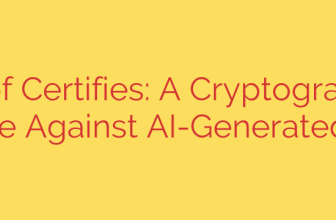
Unlocking Your Team’s Potential: A Practical Guide to Implementing the NICE Cybersecurity Framework
The NICE Cybersecurity Workforce Framework is widely recognized as the gold standard for defining cybersecurity work. Developed by the National Institute of Standards and Technology (NIST), it provides a common language to describe cybersecurity roles, skills, and knowledge. However, for many organizations, it remains an intimidating and purely academic resource—an encyclopedia of information rather than a practical, actionable tool.
The challenge isn’t the framework itself, but how to translate its comprehensive list of Work Roles, Competencies, and Knowledge, Skills, Abilities, and Tasks (KSATs) into a tangible training and development strategy. The key is to move from theory to application. This guide outlines a focused, step-by-step approach to make the NICE Framework a powerful engine for building and upskilling your cybersecurity team.
The Common Hurdle: From Comprehensive to Complicated
Many security leaders open the NICE Framework, see its vast scope, and quickly become overwhelmed. They struggle to connect its standardized definitions to their unique internal job titles and immediate business needs. This often leads to one of two outcomes: the framework is either ignored completely, or a half-hearted attempt is made to map every single role, resulting in an unwieldy project that never gains traction.
A more effective method is to treat the framework not as a rigid mandate, but as a flexible toolkit. By selectively applying its components, you can create targeted, effective, and measurable development plans that directly address your organization’s most critical security gaps.
A 5-Step Method for a Usable NICE Implementation
This training-focused approach transforms the NICE Framework from a reference document into a strategic asset. By following these five steps, you can build clear career paths, justify training budgets, and cultivate a more skilled and resilient security workforce.
Step 1: Identify Your Critical Cybersecurity Roles
Instead of trying to map your entire organization at once, start small and focus on what matters most. Identify the 3-5 most critical cybersecurity job functions essential to your security posture. These are the roles that, if left vacant or filled by an under-skilled individual, would pose the greatest risk to your business.
Examples might include:
- SOC Analyst (Tier 1 & 2)
- Incident Responder
- Cybersecurity Engineer
- Penetration Tester
By prioritizing, you ensure your initial efforts deliver the maximum impact and create a successful model you can later expand to other roles.
Step 2: Map Internal Roles to NICE Work Roles
With your critical internal roles identified, the next step is to align them with the standardized language of the NICE Framework. Go through the official list of NICE Work Roles and find the best fit for each of your positions.
For example, your internal “SOC Analyst” position likely maps directly to the NICE Work Role of Cyber Defense Analyst (PR-CDA-001). Your “Firewall Administrator” might align with Network Operations Specialist (OM-NET-001). This mapping process is crucial because it connects your organization to a nationally recognized standard, making it easier to find relevant training and benchmark your team’s skills.
Step 3: Define Clear Proficiency Levels
One of the most significant gaps in a purely academic application of the NICE Framework is the lack of defined proficiency levels. A junior analyst and a senior architect may fall under the same Work Role, but their required skills and responsibilities are vastly different.
To make the framework truly usable, define distinct proficiency levels for each critical role. A simple and effective model includes:
- Beginner/Entry-Level: New to the role, focusing on foundational knowledge and guided tasks.
- Intermediate: Can work independently on common tasks and is developing specialized skills.
- Advanced/Expert: Can handle complex, non-routine issues, mentor others, and contribute to strategy.
Defining these levels is the foundation for creating meaningful career progression and targeted training.
Step 4: Select and Prioritize Relevant KSATs
This is where you trim the fat from the NICE Framework. For each role and proficiency level you’ve defined, review the exhaustive list of KSATs associated with the mapped NICE Work Role. Your goal is to select only the KSATs that are relevant and necessary for an individual to succeed at that specific level.
For an entry-level Cyber Defense Analyst, you might prioritize KSATs related to recognizing attack signatures, using security information and event management (SIEM) tools, and following established incident response procedures. For an advanced analyst, you would add KSATs focused on proactive threat hunting, malware analysis, and developing new detection rules. This selective process makes training focused, efficient, and directly tied to job performance.
Step 5: Build Actionable Training and Development Plans
With your prioritized KSATs in hand, you can now build a concrete training plan. The goal is to find or create training content—whether it’s courses, labs, or certifications—that directly teaches and validates the specific skills you’ve identified.
This final step connects the entire process to a tangible outcome. Instead of purchasing generic “cybersecurity training,” you can now justify investments with precision. For example, you can say, “We need this specific threat hunting course to elevate our intermediate SOC analysts to an advanced level, addressing the KSATs required for proactive defense.”
This creates a clear, data-driven roadmap for employee development, showing team members exactly what they need to learn to advance in their careers.
Building a Stronger, More Resilient Security Team
By adopting this practical, training-focused approach, the NICE Framework becomes more than just a government document. It transforms into a strategic tool for talent management and risk reduction. This method helps you:
- Create clear and motivating career pathways for your cybersecurity staff.
- Objectively identify and address skills gaps within your team.
- Justify training budgets with data tied directly to business needs and risk mitigation.
- Standardize job requirements, improving the quality of hiring and performance reviews.
Ultimately, making the NICE Framework usable is about being selective and strategic. By focusing on your most critical roles and building targeted development plans, you can unlock its true potential and cultivate the expert cybersecurity workforce needed to defend your organization against modern threats.
Source: https://www.helpnetsecurity.com/2025/10/10/research-nice-framework-training/








